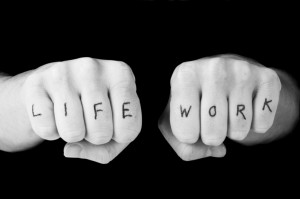Are you keeping the balls in the air? Keeping the plates spinning? Walking the fine line? Surfing the waves? There are a handful of metaphors that are commonly used to describe the intersection of work and life. They help us visualize the challenges we face in managing multiple roles and a range of responsibilities. They also offer some insight into how we can manage our work and lives better. Some of the metaphors are more helpful than others, and sometimes they simply aren’t a good representation of what is really going on. It’s worth taking a closer look.
Juggling
We often “juggle” our roles and responsibilities. Like a master juggler with many balls in the air, we endeavor to keep each part of our lives, the balls, moving, arching in the air with a precise catch and throw pattern, so we don’t drop any. There is also the accompanying saying, “Don’t drop the ball.” This evokes the image of two or more jugglers tossing tasks, like balls, between them.
There are several good points to this metaphor. First, it illustrates the way we have several balls in the air at one time. Dropping a ball may throw off the whole juggling sequence and adding more balls makes the juggling even more difficult. Second, it demonstrates the fluid and precise motion that is required to catch and release, catch and release, again and again. Finally, we can imagine the amount of concentration and focus it takes for the juggler to keep the balls moving.
Balance
The metaphor of balance is almost synonymous with work-life studies. Achieving work-life balance envisions a scale measuring the time and energy devoted to work and life in an effort to make them equal. Being out of balance means the scale is tipped in favor of one area leaving the other area too light. If we are seeking balance, we must re-allocate some of the resources from one side of the scale to the other until we find the balance point when the two sides are equal.
This metaphor is helpful in revealing when one area is neglected or when one person in a relationship is doing significantly more than the other person. The concept of balance is built on the idea of equality between the spheres of work and life. However, some people, like Jon Gordon author of The Seed: Finding Purpose and Happiness in Life and Work, claim that work-life balance is a myth that can never be realized (he suggests dancing as a metaphor instead). Perhaps one of the downfalls of this metaphor is that it fails to capture the dynamic essence of the ebb and flow of life. Still, the idea of balance is useful for identifying areas that need more of our attention.
Surfing (or tubing)
Life is inherently unpredictable, with a natural ebb and flow that resemble the waves of the ocean that bring the rising or falling tide. Some days the waves are higher and other days the sea is calmer. In her book Lessons in Buoyancy, Kathy Vick reflects on the way riding the waves in an effort to stay afloat is a good metaphor for managing unexpected challenges.
We often encounter the unexpected, and one wave can overturn our perfectly laid plans. Keeping our “heads above water” is an important part of this metaphor as we navigate choppy seas. The image of surfing the waves gives us hope that we can rise above the challenges and use them to our advantage. It also captures the truth that waves will inevitably roll in, the important thing is whether we resist the flow or move with it.
Share your insights! What is your favorite work-life metaphor and what lessons does it teach?

[…] Work-life metaphors offer insights about the dynamic interaction between work and life spheres. In this second part, we will explore four more common metaphors that offer lessons for managing the many roles and responsibilities we have everyday. If you didn’t see Part 1, you can find it here. […]